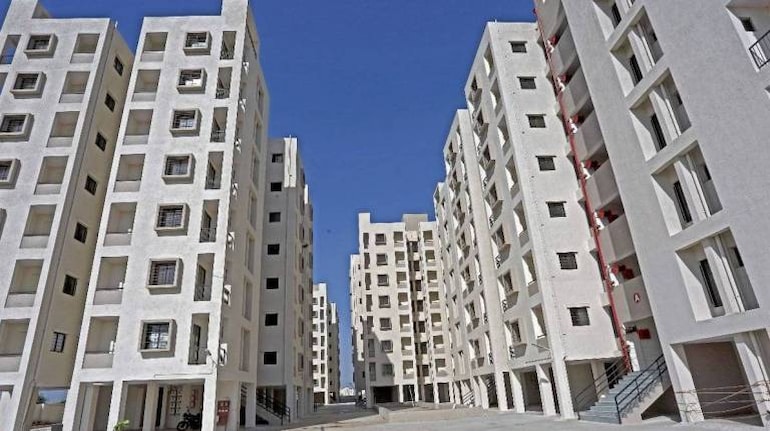



As many as 1.53 crore houses have been constructed under the flagship housing scheme Pradhan Mantri Awas Yojana, interim Finance Minister Piyush Goyal said in his Budget speech on February 1.
"During the period 2014-18, a total number of 1.53 crore houses have been built under the Pradhan Mantri Awas Yojana (PMAY)," he said.
The number includes houses under the rural and urban schemes.
Prime Minister Narendra Modi’s flagship scheme the Pradhan Mantri Awas Yojana or PMAY has received an allocation of Rs 25,853 crore compared to Rs 26,405 crore in 2018, an almost 2 percent decrease over last year.
In the FY2019 budget, the Government had also announced a dedicated affordable housing fund, which was expected to benefit banks and housing finance companies raise financing to increase their exposure to the affordable housing loan segment and thus support the PMAY programme implementation.
The government earlier this week had approved over 4 lakh houses under its Pradhan Mantri Awas Yojana (Urban), taking the total number of houses sanctioned under the scheme to over 72.5 lakh. The approval was given at the 42nd meeting of the Central Sanctioning and Monitoring Committee held on January 30.
As much as Rs 6,500 crore had been allocated for the scheme in Budget 2018. This allocation was to take care of the interest subsidy until 2022. In Budget 2018, the government had also announced a dedicated affordable housing fund, which was expected to benefit banks and housing finance companies raise financing to increase their exposure to the affordable housing loan segment and thus support the PMAY programme implementation.
Early last year, the Union Cabinet had approved the creation of Rs 60,000-crore National Urban Housing Fund to finance the government's Housing for All programme in the urban areas. The said funds, proposed to be raised through non-budgetary sources, were to be used for the next four years.
The Housing for All by 2022 initiative was launched by the Modi government within five months of assuming office.
Affordable housing has also been accorded infrastructure status, ensuring developers in this segment have access to cheaper loans.
The Credit Linked Subsidy Scheme for the Middle Income Group (CLSS for MIG) was announced by Prime Minister Narendra Modi on December 31, 2016 and was earlier extended twice till March 2019. The government in the last week of December 2018 extended the interest subsidy scheme till March 2020 for first time urban home buyers who have annual income between Rs 6 lakh and Rs 18 lakh.
Till now over 93,000 people from this income group (MIG) have availed the Rs 1,960 crore interest subsidy from the Centre, which has been disbursed through banks. Overall, until December 30 this year, around 3.39 lakh beneficiaries have availed the CLSS under the PMAY (Urban) and the total subsidy released was Rs 7543 crore.
For the MIG I category, which consists of individuals with an annual income of Rs 6-12 lakh, an interest subsidy of 4 percent is provided on a loan of up to Rs 9 lakh. For the MIG II category, which is made up of individuals with an annual income of Rs 12-18 lakh, an interest subsidy of 3 percent is given on a loan of up to Rs 12 lakh. The benefits are typically up to Rs 2.67 lakh on home loans.
The carpet area of a housing unit was initially revised to up to 120 sq m and up to 150 sq m for MIG I and MIG II respectively in November, 2017 and further enhanced to up to 160 sq m and up to 200 sq m for MIG I and MIG II, respectively in June, 2018.
Land is the biggest challenge for implementing this scheme. Its current shortage in major city-centric areas prevents the development of affordable housing in areas where it is most direly needed. The cost of land currently accounts for as much as 30-50 percent of the cost of a project within city limits. However, RBI regulations do not allow banks to fund land purchase.
On the demand side, securing financing for eligible buyers from banks and housing finance agencies is not an easy task. As the scheme targets EWS and LIG households who work in the informal sector, documentation required to avail of finance under the scheme is a challenge. Besides, delinquencies on repayment of loans taken for purchase of affordable houses has already started to rise and could deter lenders from sanctioning fresh loans if the trend persists. Reserve Bank of India (RBI) has also cautioned against loan sanctions for affordable houses.
vandana.ramnani@nw18.com
Discover the latest Business News, Sensex, and Nifty updates. Obtain Personal Finance insights, tax queries, and expert opinions on Moneycontrol or download the Moneycontrol App to stay updated!
Find the best of Al News in one place, specially curated for you every weekend.
Stay on top of the latest tech trends and biggest startup news.